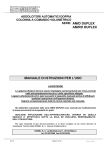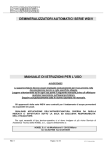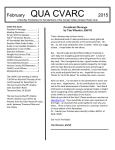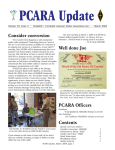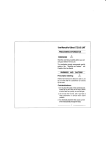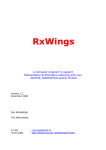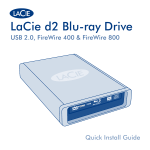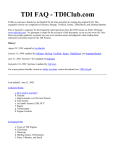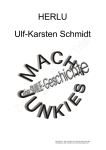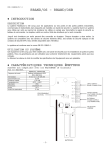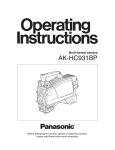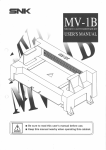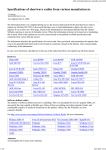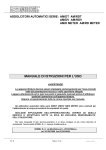Download December - Orange County Amateur Radio Club
Transcript
RF ORANGE COUNTY AMATEUR RADIO CLUB, INC. VOL. XLVI NO. 12 P.O. BOX 3454, TUSTIN, CA 92781-3454 de: Ken Konechy, W6HHC The club Christmas Dinner is coming up soon on Friday, Dec 16, at the Jagerhaus on Ball Road in Anaheim. Dan N6PEQ and Kristin K6PEQ have arranged for a SUPER RAFFLE at the dinner party. The main prize is an ICOM-7000 rig!!! You must be present to win. From my view as Prez in 2005, I think that the OCARC did very well this year. We grew our membership, had great presentations at meetings, had fun events like Field Day and a club Potluck, and participated in community service events like helping local police departments in the Baker-2-Vegas race. A radio club is only successful because members pitch-in to make it a fun club. So, I would like to thank the board members for pitching-in. Thanks Willie-N8WP for making sure we had good programs, offering to be one of the “rotating editors” for the newsletter, and being our FD organizer – great location and great steaks. Thanks Rich-KE6WWK for capturing our club minutes, for getting OCARC recognized as an ARRL Special Services Club, and talking so many club members in to helping at the B2V race through COAR. Thanks Cheryl-KG6KTT for keeping the club finances so well organized and so well reported and for organizing our December Dinner. Thanks to Kristin-K6PEQ for obtaining those great monthly raffle prizes, for encouraging me to buy more raffle tickets, for organizing the club Potluck event, for being an extraordinary “rotating” editor of the club magazine, and representing OCARC at the OCCARO meetings. Thanks Dan-N6PEQ for pitching in when the Membership position needed some help, for sending out nice invitation flyers to prospective members, for being such a good BBQ chef at the Potluck, and for smooth talking so many donations for our Christmas Dinner raffle. Thanks to Kenaan-N6CCE for storing the club’s equipment, writing great RF articles, volunteering to be a newsletter “rotating” editor, and being such a “top gun” band captain at Field Day. Thanks to Bob-AF6C for helping to launch the great “rotating editor” program for the newsletter this year, for designing a great OCARC advertising poster to place at HRO, for designing the outstanding trifold flyer to advertise the club at HRO and the OC Fair, for being our craftsman badge maker, and for running the 10M/15M weekly net for many, many years. And I want to thank our two Directors-at-Large this year, LowellKQ6JD and Steve-N1AB, who made my job much easier by taking on every task that I threw their way...you guys really helped me. See you at the Christmas Dinner! Details inside! DECEMBER 2005 There will be no regular December meeting. Instead the club will hold its December Christmas Dinner on the 16th, which by coincidence is a third Friday meeting date.. The Dinner will be at Jagerhaüs in Anaheim. See pages 10 and 11 for a map and more details, Contact our Treasurer for tickets. Don’t miss it.! It’s going to be an extravaganza – dinner and raffle! The next regular meeting will be: Friday, Jan. 20th 2006 @ 7:00 PM We will be meeting on the 2nd floor in the east bldg. In This Issue: Page THE PREZ SEZ ..................... 1 NO DECEMBER MEETING ..... 1 CLUB INFORMATION ............. 2 30 MTR ANTENNA Pt. III ......... 3 PRODUCT SPOTLIGHT JRC NRD-545 Receiver ........ 4 CLUB E-VOTE ....................... 8 Errata: MEETING ADDRESS ....9 SPECIAL THANKS ................ 8 YAESU JOB OPENING ........... 9 FCC ACTION: 147.435 R ........ 9 NOV. MEETING MINUTES .... 10 HOLIDAY DINNER MAP ... 10 DINNER RAFFLE PRIZES .... 11 DEC. BOARD MINUTES ....... 12 Next Club Breakfast & Open Board Meeting Sat. Jan. 7th 2006 THE ORANGE COUNTY AMATEUR RADIO CLUB, INC. P.O. Box 3454, Tustin, CA 92781 Technical: Kenan Reilly, N6CCE (714) 543-5073 [email protected] Members At Large: Steve Brody, N1AB (714) 974-0338 [email protected] Lowell Burnett, KQ6JD (714) 997-0999 [email protected] 2005 Club Appointments: 2005 Board of Directors: President: Ken Konechy, W6HHC (714) 744-0217 [email protected] Vice President: Willie Peloquin, N8WP (714) 318-4047 [email protected] Secretary: Rich Helmick, KE6WWK (714) 343-4522 [email protected] Treasurer: Cheryl Peloquin, KG6KTT (714) 318-4042 [email protected] Membership: Dan Dankert, N6PEQ (714) 544-9846 [email protected] Activities: Kristin Dankert, K6PEQ (714) 544-9846 [email protected] Publicity: Bob Eckweiler, AF6C (714) 639-5074 [email protected] December 2005 - RF Page 2 W6ZE Trustee: Bob Eckweiler, AF6C (714) 639-5074 [email protected] Club Historian: Bob Evans, WB6IXN (714) 543-9111 [email protected] RF Editor for December: Bob Eckweiler, AF6C (714) 639-5074 [email protected] WEB Master: Ken Konechy, W6HHC (714) 744-0217 [email protected] ARRL Assistant Director: Ken Konechy, W6HHC (714) 744-0217 [email protected] ARRL Awards Appointee: Larry Beilin, K6VDP (714) 557-7217 [email protected] OCCARO Delegate: Kristin Dankert, K6PEQ (714) 544-9846 [email protected] Monthly Events: General Meeting: Third Friday of the Month At 7:00 PM American Red Cross 600 Parkcenter Dr. (near Tustin Ave. & 4th St) Santa Ana, CA Club Breakfast: First Saturday of the month at 7:30 AM Katella Grill 1325 W. Katella Ave. (SE Corner at Main St.) Orange, CA Club Nets (Listen for W6ZE): 7.086 MHz CW OCWN Sun - 9:00 AM - 10:00 AM Rick KF6UEB, Net Cntl. 28.375± MHz SSB Wed - 7:30 PM - 8:30 PM Bob AF6C, Net Control 146.55 MHz Simplex FM Wed - 8:30 PM - 9:30 PM Bob, WB6IXN, Net Control VISIT OUR WEB SITE http://www.w6ze.org for up-to-the-minute club information, the latest membership rosters, special activities, back issues of RF, links to ham-related sites, vendors and manufacturers, pictures of club events and much much more. Club Dues: Regular Members ...... $20 Family Members* ...... $10 Teenage Members ...... $10 Club Badge** ................ $3 Dues run from January thru December & are prorated for new members. *Additional members in the family of a regular member pay the family rate up to $30 per family. **There is a $1 charge if you’d like to have your badge mailed to you. Techtalk #46 A Shortened 30M Dipole – Part III of III “How It Actually Performs” by Ken Konechy – W6HHC In the Part I (March 2005 issue of RF) of this series, I walked thru the steps of designing a “shortened 30M vertical” antenna using the knowledge from the WinNEC antenna modeling program-and-class offered by the ARRL. In Part II (November 2005 issue), I showed how to build/construct the 30M antenna from aluminum tubing, some PVC piping and do-it-yourself loading coils. In this months article of this three-part series, Part III discusses actually tuning-up the antenna, comparing SWR readings, and on-the-air QSO results. In the Part II I had shown a drawing of how to construct a simple “tower” for the 30M antenna using a 10-foot section of 2x4 lumber. In Figure 1, I show how the completed 30M antenna and tower look in my backyard. The entire length of the 30M antenna is just over 11 feet and the center of the antenna is shown at 10 Feet. I used a 1:1 balun (made by Van Gordon) that I bought at the recent club auction to feed coax to the balanced antenna at the feedpoints. If you don’t use a balanced balun, then ensure that the ground side of the coax feeds the bottom side of the vertical. In Figure 2, I show the SWR predicted by NEC-Win antenna modeling program for the 11-foot, 1-inch overall length of the 30M antenna. The “real world” always varies from perfect models – probably variation of inductance in my hand-wound 16.5 uH loading coils. Figure 3 shows that actual SWR measurement that I first obtained. So I could either tweak the coils (could be very labor consuming) – or I could use the computer to tell me how much to adjust the length of the antenna. The darker line in Figure 3 shows that the resonant frequency is higher than desired (around 10.185 MHz instead of the desired 10.125 MHz) – so by lengthening the antenna I can adjust the resonance down to exactly where I want it. VSWR vs. Frequency 2.9 30M-short vert-dipole 11-ft-1-inch V 2.8 S 2.7 W R 2.6 2.5 10.10 10.11 10.12 10.13 Frequency MHz 10.14 10.15 Figure 2 – NEC-Win Predicted SWR for 11-foot-1-inch Antenna 2.2 Actual VSWR Measurements 2.0 V 1.8 S W 1.6 R 1.4 1.2 1.0 10.10 Len = 11’ 1” Len = 11’ 3” 10.12 10.14 10.16 10.18 Frequency MHz Figure 3 I played with the antenna length on the NEC-Win computer program and found that if I change the length on the two outer pieces of aluminum so that the overall length was 11-foot-3-inches (add one inch to each end), then the resonance would shift down by 60 KHz. The lighter line in Figure 3 shows the actual SWR measurements after adjusting the antenna length to 11-foot-3-inch. Almost perfect – certainly good enough to use. I should have made it 11-foot3.5-inch. Figure 4 shows a close-up detail of how I added the 1-inch wire to the ends of the element. Just some 14-guage solid copper wire, a solder lug, and a stainless steel 1/4-inch bolt. Figure 1 – 30M Shortened Dipole Mounted as a Vertical on Simple Tower So, it is now time to make a contact!!! Learning CW again after many years takes a few days of practice. The 30M band is just CW and digital PSK-31 data. So I went slowly – but here is a list of my first four QSOs on 30M. See Antenna - on Page 10 December 2005 - RF Page 3 *** Product Spotlight *** Japan Radio Company (JRC) Model NRD-545 HF/VHF/UHF DSP Receiver By: Dan Dankert N6PEQ [email protected] I recently found myself in the marketplace for an all-mode receiver with wide-band frequency coverage. My frequency range of interest was 0 MHz thru 2000 MHz. There is not a wide selection of radios currently available to the average consumer for this entire frequency range. Typically you either purchase a new receiver, such as AOR’s model AR3000 or AR5000, or Yaesu’s model VR-5000. Used receivers that fit the bill are Icom’s IC-R8500 and IC-R9000L. It turned out that there was one other option. This is the Japan Radio Company (JRC) model NRD-545 DSP receiver. This receiver comes standard with all-mode capability covering 0.1 MHZ to 29.9999 MHz. An optional wide-band receive board (CHE-199) is available which extends the all-mode frequency coverage up to 1999.9999 MHz. I had not previously owned a piece of JRC equipment, but I was aware of their legendary performance. JRC receivers are used quite extensively by ship-board radio operators because of their impressive receiver characteristics and non-fatiguing audio quality. The table below indicates some of the specifications for the NRD-545 receiver. After a detailed review of the NRD-545 literature, and a few phone calls to some friends knowledgeable in high-end receivers, the decision was made to purchase the NRD-545. After a quick email to HRO, my new receiver was on its way from JRC America, soon to arrive at my home QTH. Eagerly awaiting the arrival of the unit, I wired up a few cables ahead of time, so that I would minimize setup time. Once the JRC package was delivered, it took only a short duration to get it fired up. There’s nothing quite like the smell of a new piece of radio equipment. Time to play! Japan Radio Company (JRC) Model NRD-545 Manufacturers Specifications 0.01 to 29.9999 MHz (0.01 to <0.1 MHz Specifications Not Guaranteed) Frequency Coverage 0.01 to 1999.9999 MHz (Less Cellular) with Optional CHE-199 Wide-Band Converter Board Installed USB, LSB, CW, RTTY, AM, FM Reception Modes WFM (With Optional CHE-199 Installed) ± <10 ppm (5 to 60 minutes after Power Up) Frequency Stability ± 2 ppm (>60 Minutes after Power Up) ± <0.5 ppm (with Optional CGD-197 TCXO Installed) Triple Conversion Superheterodyne >70 dB Image Rejection Receiver >60 dB Spurious Response >70 dB IF Rejection 106 dB Dynamic Range (300 Hz IF Bandwidth) 13” W x 5.62”H x 12.9”D Size/Weight 16.5 lbs (Without Options) Power Requirements 12 to 16 VDC or 100/120/220/240 VAC 0.2 to 29.9999 MHz: 50 Ohm “UHF” Female Jack Antenna Connectors & 600 Ohm Wire terminal 30 to 1999.9999 MHz: 50 Ohm “N” Female Jack Front Panel Ergonomics... The front panel of the radio, pictured below, has a clean layout with wellspaced buttons and knobs. There is no over use of real estate happening here! The display is bright, and has a large and easy to read frequency readout. The digital bar graph S-meter features a peak hold function. The tuning knob is solid and has a nice feel to it. Direct keyboard entry of frequency makes for quick QSYing. There are buttons for three user adjustable filter settings. Other “typical” controls are found such as tone, AF gain, RF gain, squelch, notch filter, mode selection, clock, timer, dimmer, attenuator, scan functions and frequency lock. Front Panel View December 2005 - RF Page 4 “Cool” Features... • The NRD-545 features DSP noise reduction. The level of the noise reduction aggressiveness is selectable via a menu function. There are 256 different levels of noise reduction available to choose from. The DSP is accomplished using a one-chip DSP shown in the picture to the right. • A beat canceler is also provided, which is adjustable among 256 different settings via a menu function. • In addition to the standard “AM” reception mode, the NRD-545 offers a “AMS” mode. The “AMS” mode is a high-fidelity (Hi-Fi) version of AM reception. • Not only is a notch feature available, but also offered is a “notch tracking” DSP Chip mode! You press the notch button to activate the notch circuitry, then using the adjustment knob, you manually notch out the carrier that you desire to eliminate. Then you press the notch button again. This places the notch into “tracking” mode. The notch will then continuously track the specific carrier that you notched, as you tune the main tuning dial within +/- 10 KHz from the start frequency. Neat feature! • A very advantageous feature of the NRD-545 is the “ECSS” mode. ECSS stands for “Exhalted Carrier Selectable Sideband”. If you listen to an AM signal that is exhibiting signal distortion due to signal fading, you would engage the ECSS mode to counteract the band conditions that are resulting in the signal fading. In standard AM transmissions, double sideband (DSB) is used, in which the modulated signal is transmitted in both upper sideband (USB) and lower sideband (LSB). In the ECSS mode, you listen to the AM signal in a single sideband (SSB) configuration. By pressing the “ECSS” button, you toggle between utilizing the USB or LSB component of the modulated AM signal for listening, while providing a locked carrier signal. This reduces audio distortion and fading, since in many cases only the USB or LSB side of the AM signal is being primarily affected by the phenomena, which is called “selective fading”. • Numerous tuning steps are available including 1 Hz, thanks to a one-chip DDS (Digital Direct Synthesizer). The 1 Hz tuning is especially helpful in tuning PSK and RTTY signals. The entire selection of available tuning steps is 1 Hz, 10 Hz, 100 Hz, 1 KHz, 5 KHz, 6,25 KHz, 9 KHz (Nice for foreign MW BCB DXing), 10 KHz, 12.5 KHz, 20 KHz, 25 KHz, 30 KHz, 50 KHz & 100 KHz. • In the USB, LSB, CW & RTTY modes, the AGC discharge time is continuously adjustable between 0.04 seconds to 5.1 seconds in 20 millisecond increments. • Pass-Band Shift (PBS) is variable within the range of +/- 2.3KHz on 50 Hz steps. This simply shifts the digital IF filter upward or downward to reduce interference from adjacent frequencies. • Pass-Band filtering is adjustable from 10 Hz to 9.99 KHz in 10 Hz increments. Each of the three user adjustable filters can be individually set to the pass-band filter width of your preference. • A RTTY demodulator is built into the receiver. The demodulator deciphers RTTY signals with widths of 170 Hz, 425 Hz or 850 Hz, and with rates ranging from 37 to 75 baud. The demodulated signals can be displayed through the use of a computer utilizing the RS-232C port on the rear panel of the NRD545. • The tuning knob has a handy torque adjustment. The torque adjustment control is conveniently located directly underneath the tuning knob making for swift altering. Rear Panel View December 2005 - RF Page 5 Rear Panel Connections... Pictured on the previous page is the rear panel of the NRD-545 receiver. The “typical” types of connections are available, such as 13.8 Vdc power input, 100/120/220/240 Vac power input, external speaker output, timer relay output for automatically triggering a recording device, RS-232C port for computer control and RTTY demodulation display, “UHF” type antenna input for HF, “N” type antenna input for UHF/VHF (optional CHE-199 required), high impedance antenna input, a toggle switch for selection between the “UHF” or the high impedance antenna for the HF bands, ground terminal, “DC Out” jack (10.8 Vdc output @ 30 mA), right and left line outputs for speakers and a mute jack for use in combination with a transceiver/transmitter. I find the “DC Out” jack to be quite useful to activate my +15 dB preamplifier, which I installed inline between the antenna and the NRD-545. The NRD-545 offers just enough current to power up my preamplifier. Internal Construction... The inside of the NRD-545 is unique as compared to most receivers. As you can see from the picture to the right, the NRD-545 features modular construction with plug-in P.C. boards on its motherboard. This gives the inside of the radio a very simple yet attractive look. Since I purchased the optional high-stability TCXO and wide-band receive board, the plug-in boards made installation of these items a breeze! JRC provides two helpful lever tools to assist in removal of the internal P.C. boards. Optional Accessories... Pictured below left is the CHE-199 wide-band receive board. This is the component that provides the receiver with reception capabilities up to Top View with Cover Removed 1999.999 MHz! The board is simply plugged into the NRD-545’s motherboard. A small coaxial cable that is already furnished inside of the NRD545’s chassis, is then plugged into a female coax jack located on the CHE–199 board. After the installation is complete, you must initialize the radio by pressing the “CLR” button while powering up the NRD-545. This is a one-time initialization to activate the UHF/VHF reception capabilities. Optional Wideband Receive Card The installation of the CGD-197 high-stability TCXO (pictured at the right) is a little more involved than that of the CHE-199. First, you remove the “REF/DDS” from the NRD-545 chassis. The CGD-197 TCXO is then soldered onto this board in a pre-marked location. The REF/DDS board is labeled very clearly, and the CGD-197 TCXO can only be orientated in one direction on the board. A small jumper located on the REF/DDS board is then swapped between two rows of pins to actuate the TCXO. The REF/DDS board is then reinstalled into the NRD-545 chassis. This completes the installation of the high-stability TCXO. The December 2005 - RF Page 6 photo on the left shows the TCXO mounted on the top-left quadrant of the REF/DDS board right above the green jumper. REF/DSS Card with TCXO Installed JRC NVA-319 Speaker Pictured below left, the JRC NVA319 external speaker for the NRD545 offers three different audio response cuts, as well as inputs for two separate radios. The NVA-319 has nice audio quality. The speaker matches the height, color and finish of the NRD-545 receiver. As with any high-end receiver, an external speaker is essential in order to capitalize on the exceptional receiver characteristics and cutting edge features of the NRD-545. At the time of my purchase, the NRD545 came supplied with the JRC model ST-3 headphones. Pictured to the right, The ST-3 has a good solid feel to them, while at the same time remaining quite lightweight. The audio has good fidelity and tone quality. The cable coming from the headphones is of a larger diameter than that of most other consumer grade headphones, which should result in longer cable life after years of excessive flexing. NRD-545 Headphones On The Air Performance... So does the radio perform? Yes! The receiving performance proved to be excellent. The receiver is sensitive and quiet. The DSP filter aggressively attacks noise, while at the same time enhancing signal quality. With the NRD-545’s DSP capability, it is routine to convert a signal that is scarcely distinguishable to one of full readability. The world of DSP is fantastic! If you have not yet taken advantage of this leap in technology, you are missing out! The pass-band shift feature does an excellent job of eliminating unwanted signals. The ability to adjust the filter bandwidth as tight as 10 Hz really is very beneficial. Although significantly effective in AM, SSB & RTTY modes, I found this feature to be especially useful while receiving CW signals in close proximity to one other. The noise blanker is adequate, and it has typical performance as compared to most other radios. The notch filter provides for a very sharp and deep null of a heterodyne. The notchtracking feature works great! I found it very advantageous to be able to notch a specific heterodyne, and still be able to tune the main dial somewhat without the necessity of readjusting the notch filter. The receiver’s selectivity is outstanding. Of the numerous radios that I have operated over the years, the NRD-545 is one of best radios at reducing or eliminating interference from an exceedingly strong adjacent signal. The radio accomplishes this with minimal work from the operator. A quick press of a button or two, and a few turns of a knob or two, and presto! I found the audio quality to be very clean and full. The audio is easy on the ears, even after hours of constant listening. The “AMS” (Hi-Fi) mode has an extraordinarily nice sound to it. Another feature, which created a more pleasing listening environment, is the exhalted carrier selectable sideband “ECSS” mode. This mode really works nicely! Most SWBC signals, that I found experiencing selective fading, were vastly improved by using the ECSS mode. During selective fading, the signal’s audio can become distorted and sometimes be very harsh on the ears. With a push of the “ECSS” button, the received audio is significantly enhanced. I found myself using this feature constantly, and my ears benefited from the more pleasant sound. I do not know how I lived without it! This is one the highlights of this radio. I was grateful for the well thought out design of the main tuning knob. The knob’s torque adjustment allows for a proper feel of tuning control under varying operating conditions. My hand did not suffer from fatigue due to the positioning of the dial. In fact, all of the knobs and buttons tended to have a solid “quality” feel to them. For the most part, the layout of the radio’s front panel made for quick access of functions. With the buttons and controls well spaced, there is no need to call out a search party to locate a specific function. In order to initiate reception from 10 KHz to <100 KHz, you December 2005 - RF Page 7 must press the “ENT/KHz button while powering up the radio. In order to activate USB/LSB/CW/RTTY modes above 30 MHz, you must press the “USB/LSB” and “CW/RTTY” buttons while powering up the NRD-545. In both of the cases, JRC does not guarantee the receiver specifications for these additional features added by these modifications. I found the SSB and CW modes to work well in the VHF/UHF spectrum. Odds & Ends... The NRD-545 has the ability to be computer controlled. This is accomplished B through the RS-232C port on the rear panel. JRC offers a simple “no frills” Windows based program to get you started in controlling the radio with your computer. In addition to controlling the basic features of the radio, the software also allows you to display decoded RTTY signals on your computer screen using the NRD-545’s built in RTTY demodulator. The instruction manual for the radio provides additional information on the commands used to operate the radio via computer. I did not attempt computer control of the radio, nor did I execute the software. The NRD-545 has the ability to store up to 1,000 memories. Each memory saves the frequency as well as mode, IF bandwidth, AGC setting, attenuator setting, and tuning step increment. The first 20 memories also can store on/off times for the internal timer and timer relay output. Conclusion... I found myself truly appreciating the NRD-545’s advanced features and capabilities. The receiver performance is excellent. The ability to eliminate band noise and adjacent frequency interference while retaining signal integrity of the target signal is superb. I enjoyed the simplicity of the front panel controls, which resulted in efficient tuning. After significant scrutiny, I was unable to discover any defects in the receiver. The construction of the radio is robust and sturdy. I expect to experience many December 2005 - RF Page 8 years of pleasurable radio listening with the NRD-545. There are only a few specific items that I would change: • First, the manual should be written in better English, and also provide better detail of the use of specific functions. • The surface-finish of the front panel buttons look attractive, but they tend to overly reveal the oils deposited by fingertips. • I would like to see the DSP noise reduction and beat canceler to be adjustable via a knob on the front panel of the radio rather than through a less convenient menu system. • The “Fine Control”, which is used to adjust the digital IF filter bandwidth and AGC discharge time constant, should be “speed sensitive”. I found that since the adjustment increment is constant, that it sometimes took much longer than it should to tweak in the adjustment to your preference. If this knob could sense that you were turning the knob fast, and in turn SPECIAL CLUB VOTE: In a new first for the club, President Ken - W6HHC held the first Board vote over the Internet. The Board e-voted unanimously to authorize $300 in prize money for the Christmas Dinner raffle. This money is in addition to the many donated prizes that Dan - N6PEQ and Kristin - K6PEQ have arranged. Errata: CLUB MEETING ADDRESS: For the past few years we have been giving the address of the Red Cross Building where we hold the meetings as 601 N. Golden Circle. Actually this is the west bldg, where we did meet occasionally. The address of the building where we meet regularly is 600 Parkcenter. A BIG CLUB THANK YOU… …to the following businesses for supporting and donating prizes to our club. Please support these fine increase the adjustment increment based upon this, it would result more proficient operating. If you happen to be in the market for a receiver with high-end performance for the HF or HF/VHF/UHF frequency spectrums, I would recommend considering the JRC NRD545 receiver. The NRD-545 is a formidable candidate for the task! Manufacturer Information... More information on the JRC NRD545 DSP receiver can be obtained by contacting: Japan Radio Company, Ltd. 2125 Center Avenue, Suite 208 Fort Lee, New Jersey 07024 Tel: 201-242-1882 Fax: 201-242-1885 Website: http://www.jrc.co.jp Street Price: NRD-545 DSP Receiver ($1800), NVA-319 External Speaker ($200), CHE-199 VHF/ UHF Wide-Band Converter ($370), CGD-197 High Stability TCXO ($100), ST-3 Headphones ($70), 6ZCJD090350 RS-232C Cable ($60), and Service Manual ($30). companies with your purchases. Look for additional supporters in next month’s issue! Career Opportunity: Vertex Standard USA, Inc. (YAESU) Job Title: WDXC Program Manager (WDXC: “World DXers Club,” – a Customer Loyalty program) Reporting To: Vice President Job Start: Immediately Job Basis: Full-time Chief Responsibilities: You will be responsible for supervising the WDXC program at Vertex Standard USA. This is a new customer-loyalty program that builds long-term sales through a value-added partnership with current and potential customers. WDXC responsibilities include, but may not be limited to: • Overseeing the growth and maintenance of the WDXC membership; • Overseeing the WDXC Web Site, and coordinating with other departments and our Web designer in the promulgation and maintenance of timely articles, news FCC LIFTS PRIVILEGES OF LA-AREA 147.435 REPEATER The FCC alleges that problems persist on the Los Angeles area's 147.435 MHz repeater, now operated by Jeffrey Stieglitz, AE6NZ. The FCC Los Angeles District Office recently informed Stieglitz that it was suspending automatic control privileges for the repeater. That means the licensee or a designated control operator must be at the repeater's control point whenever the machine is operational. "Your amateur station AE6NZ is under review by the Enforcement Bureau for numerous and continued apparent violations of the Commissions rules," FCC LA Office District Director Catherine Deaton wrote Stieglitz November 18. The Commission alleges inadequate station control, deliberate interference, failure of users to identify and use by unlicensed operators. Stieglitz told ARRL he encourages updates, and support issues; • Overseeing and supervising the final assembly and testing of products (such as the FT DX 9000) being assembled under WDXC auspices; • Overseeing the WDXC Auction Site operations, including coordination and supervision of the efficient flow of paperwork related to the inspection, repair, and certification of previously-owned YAESU equipment; • Coordinating promotional materials and activities related to WDXC; • Attendance at such trade shows as management may deem appropriate and necessary for the advancement and expansion of WDXC and the YAESU product; • Reporting to management, on a regular basis, regarding WDXC status, problems, and opportunities. General: and broad HF transceiver knowledge. Strong English writing and communications skills are a must, and foreign language capability (especially Spanish) is definitely a plus. Computer experience is mandatory, and knowledge of Amateur Radio computer-based operations (logging software, HF Packet/ RTTY, PSK31) is also desirable. Vertex Standard USA, Inc. offers a competitive compensation and benefits package, including a 401(k) plan, medical and dental insurance, and a generous vacation schedule. If you would like to be considered for this exciting position, please send your resume to Vertex Standard USA, Inc. Attn. Mr. Jeff Quan, Chief Financial Officer, 10900 Walker Street, Cypress, CA 90630. Fax: (714) 527-1494. An Advanced or Extra Class Amateur Radio license is required, as are current active DX experience No telephone inquiries accepted. See the WDXC Web site at users of the busy repeater to comply with Part 97 rules and to make a reasonable effort to identify unlicensed operators. "I believe that the 147.435 repeater attracts people to the hobby and, overall, is consistent with the purposes of Amateur Radio," he said. FCC terminated the automatic control privileges of the thenW6NUT repeater while it was reviewing its operation. Since then the repeater has changed hands a few times, and enforcement issues seem to have followed. Deaton says if AE6NZ is operated under automatic control prior to notification from her office, enforcement action up to and including a license revocation and suspension hearing, a fine or both could follow. Deaton also asked Stieglitz to submit in advance the names and contact numbers of other licensees who serve as control operators. "During any times that no control operator is available, the repeater must be shut down," Deaton stated. The odd-split 147.435 MHz repeater (the primary input is 146.400 MHz) has been a lightning rod for controversy. In 2001, the http://wdxc.yaesu.com "As the Jack Gerritsen case shows, there is very little the FCC can actually do against a determined bootlegger," Stieglitz said. Gerritsen is set to appear in federal court next week. "In my opinion, shutting down a repeater because a third party breaks the rules just penalizes the honest operators." FCC Enforcement Bureau Special Counsel Riley Hollingsworth had another perspective: "The repeater has been out of control long enough, and we have been too patient too long," he told ARRL. Excerpt from The ARRL Letter, December 2nd. December 2005 - RF Page 9 NOV. MEETING MINUTES November 18, 2005 President Ken, W6HHC, called the group to order at 7:00 PM. Roll call was taken. Kenan, N6CCE, was out of town, all others were present. There were 26 present with visitors Fred, K6RMX; Steve, KI6ATO; Matt, KI6BLY; Vlad, KI6BLP, Frank, WF1A; and new member Paul, KQ6EH. President Ken then introduced Taka-KW6I and Jeff-AA6JR of AOR-USA who gave a very interesting presentation on “New Digital Voice Modulation”. After the break the meeting continued. The minutes of the last board meeting were approved as published. NEW BUSINESS: • Bob, AF6C (trustee of W6ZE) asked for and was given a name of someone who would print the club QSL cards for a reasonable price. • Those gathered were reminded that the Club board meets on the first Saturday of the month for breakfast. • Newly elected President Willie asked for information from the visitors regarding what they expected from the club. They responded, advice on equipment, advice on how to get into an emergency response group, advice on how to set up mobile operations equipment, getting together with hams who like to work on projects and test equipment, and learning the new techniques of ham radio. Antenna – Cont. from Page 3 • • • • W5HZA WA3SLN AA5EA KQØA - Lafayette, LA - Montourville, PA - El Paso, TX - Taos, NM So this was a very successful project. I am very satisfied with the results. I am active on 30M, now. Dan-N6PEQ is advising me on the “how to DX” characteristics of the 30M band. I have already heard a KH6 and JA7. Perhaps I could organize a club antenna building projects if other club members are interested?? Contact me if you are interested or have question on this project at: [email protected] OLD BUSINESS: • Board elections were held and the following were elected to be GOOD of the CLUB: on the 2006 board: • Dan, N6PEQ reported on recent President: DX.. Willie Peloquin, N8WP; • Tom, WA6PFA, reported that he has been monitoring SS ATV Vice President: and receiving good pictures. Kristin Dankert, K6PEQ; • Bob, AF6C reported that This Secretary: Week in Technology had a reSteve Brody, N1AB; port on how good the Heil microphone sounds. Treasurer: • President Ken reported that he Cheryl Peloquin, KC6KTT; will follow up in a future RF on Activities Chair: the 30 meter dipole he is conDan Dankert, N6PEQ; structing. Membership Chair: The meeting adjourned at 9:07 PM. Bob Eckweiler, AF6C; Respectfully Submitted Publicity Chair: Rich Helmick KE6WWK Tom Weed, K6CCD; Secretary Technical Chair: Kenan Reilly, N6CCE; Figure 4 – Close-up for Adding 1-inch wire to each end Member at Large: Lowell Burnett KQ6JD; Member at Large: Ken Konechy, W6HHC; • All were thanked for their willingness to serve. • Willie-N8WP explained the club Christmas dinner (Dec 16). • A review and discussion was held before a final collection of donations for the ARRL BPL defense fund. December 2005 - RF Page 10 Dec 16th, 7 PM at the 2525 E Ball Road, Anaheim, CA (Note: Taft Ave. in Orange becomes Ball Rd. in Anaheim) December 2005 - RF Page 11 change membership-info flow as follows: 1. The Treasurer will alert MemThe meeting was called to order by bership when monies are rePresident Ken, W6HHC. Roll call ceived and transfer over all newwas taken and all Board members member info; and then… were present except Bob, AF6C who 2. Membership will send out memwas ill. There were 15 members bership-info to all requiring club present at the meeting. Cherylfunctions. KG6KTT reported that 33 tickets OLD BUSINESS: Christmas dinto the Christmas party have been ner set up is going well. The elecsold. Treasurer Cheryl, KC6KTT, tion results from last general meetreported that the club has ing will be in the RF. The club sent $2,738.36 in the bank. Membera check for $396.00 to ARRL for ship Chair Dan, N6PEQ, reported BPL defense fund. that the club has approximately 55 members. The board agreed to NEW BUSINESS: An audit committee of Larry Hoffman, Kristin Dankert and Treasurer Cheryl will meet in the middle of January 2006 to audit the club accounts. President Ken has the name of the recipient of the Good of the Club award which will be given at the Christmas dinner. A discussion was held regarding opening a Pay Pal account for club use. Willie, N8WP, moved that the club open a Next RF Deadline: Jan 9th Pay Pal account and it was secondBoard Meeting Minutes Dec. 3, 2005 ORANGE COUNTY AMATEUR RADIO CLUB, INC P.O. BOX 3454 TUSTIN, CA 92781-3454 First Class Mail Time Dated Material. Please Expedite!! December 2005 - RF Page 12 ed by Dan Dankert. The motion passed on a voice vote. Kristin, who is president of OCCARO, suggested dates for the club to be at the OC Fair ham booth. The agreed-upon dates are July 12 and July 29. The club will “showcase” DX on one of the days. Steve N1AB suggested that the club have some younger hams in the booth this year. Willie reported that a field day committee meeting will be held in January. The meeting adjourned at 8:20 AM. Note: An e-vote was held to authorize monies for the Dinner Raffle. See page 8 for details Respectfully Submitted Rich Helmick KE6WWK Secretary With assistance from Lowell KQ6JD












